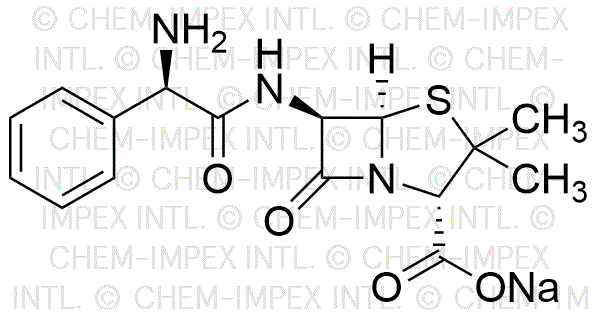Ampicillin sodium salt powder or crystals is widely utilized in research focused on:
- Antibiotic Development: This compound is a key player in developing antibiotics, particularly for treating bacterial infections. Its effectiveness against a broad spectrum of gram-positive and some gram-negative bacteria makes it invaluable in pharmaceutical research.
- Clinical Applications: Ampicillin is frequently used in clinical settings to treat infections such as pneumonia, meningitis, and urinary tract infections. Its sodium salt form enhances solubility, making it easier to administer intravenously.
- Microbiological Studies: Researchers use this compound to study bacterial resistance mechanisms. By understanding how bacteria respond to ampicillin, scientists can develop new strategies to combat antibiotic resistance.
- Formulation Development: In the pharmaceutical industry, ampicillin sodium salt is often formulated into various dosage forms, including tablets and injectables, allowing for tailored treatment options for patients.
- Veterinary Medicine: This compound is also utilized in veterinary practices to treat infections in animals, ensuring that pets and livestock receive effective care, which is crucial for public health and food safety.
General Information
Properties
Safety and Regulations
Applications
Ampicillin sodium salt powder or crystals is widely utilized in research focused on:
- Antibiotic Development: This compound is a key player in developing antibiotics, particularly for treating bacterial infections. Its effectiveness against a broad spectrum of gram-positive and some gram-negative bacteria makes it invaluable in pharmaceutical research.
- Clinical Applications: Ampicillin is frequently used in clinical settings to treat infections such as pneumonia, meningitis, and urinary tract infections. Its sodium salt form enhances solubility, making it easier to administer intravenously.
- Microbiological Studies: Researchers use this compound to study bacterial resistance mechanisms. By understanding how bacteria respond to ampicillin, scientists can develop new strategies to combat antibiotic resistance.
- Formulation Development: In the pharmaceutical industry, ampicillin sodium salt is often formulated into various dosage forms, including tablets and injectables, allowing for tailored treatment options for patients.
- Veterinary Medicine: This compound is also utilized in veterinary practices to treat infections in animals, ensuring that pets and livestock receive effective care, which is crucial for public health and food safety.
Documents
Safety Data Sheets (SDS)
The SDS provides comprehensive safety information on handling, storage, and disposal of the product.
Product Specification (PS)
The PS provides a comprehensive breakdown of the product’s properties, including chemical composition, physical state, purity, and storage requirements. It also details acceptable quality ranges and the product's intended applications.
Certificates of Analysis (COA)
Search for Certificates of Analysis (COA) by entering the products Lot Number. Lot and Batch Numbers can be found on a product’s label following the words ‘Lot’ or ‘Batch’.
*Catalog Number
*Lot Number
Certificates Of Origin (COO)
This COO confirms the country where the product was manufactured, and also details the materials and components used in it and whether it is derived from natural, synthetic, or other specific sources. This certificate may be required for customs, trade, and regulatory compliance.
*Catalog Number
*Lot Number
Safety Data Sheets (SDS)
The SDS provides comprehensive safety information on handling, storage, and disposal of the product.
DownloadProduct Specification (PS)
The PS provides a comprehensive breakdown of the product’s properties, including chemical composition, physical state, purity, and storage requirements. It also details acceptable quality ranges and the product's intended applications.
DownloadCertificates of Analysis (COA)
Search for Certificates of Analysis (COA) by entering the products Lot Number. Lot and Batch Numbers can be found on a product’s label following the words ‘Lot’ or ‘Batch’.
*Catalog Number
*Lot Number
Certificates Of Origin (COO)
This COO confirms the country where the product was manufactured, and also details the materials and components used in it and whether it is derived from natural, synthetic, or other specific sources. This certificate may be required for customs, trade, and regulatory compliance.


